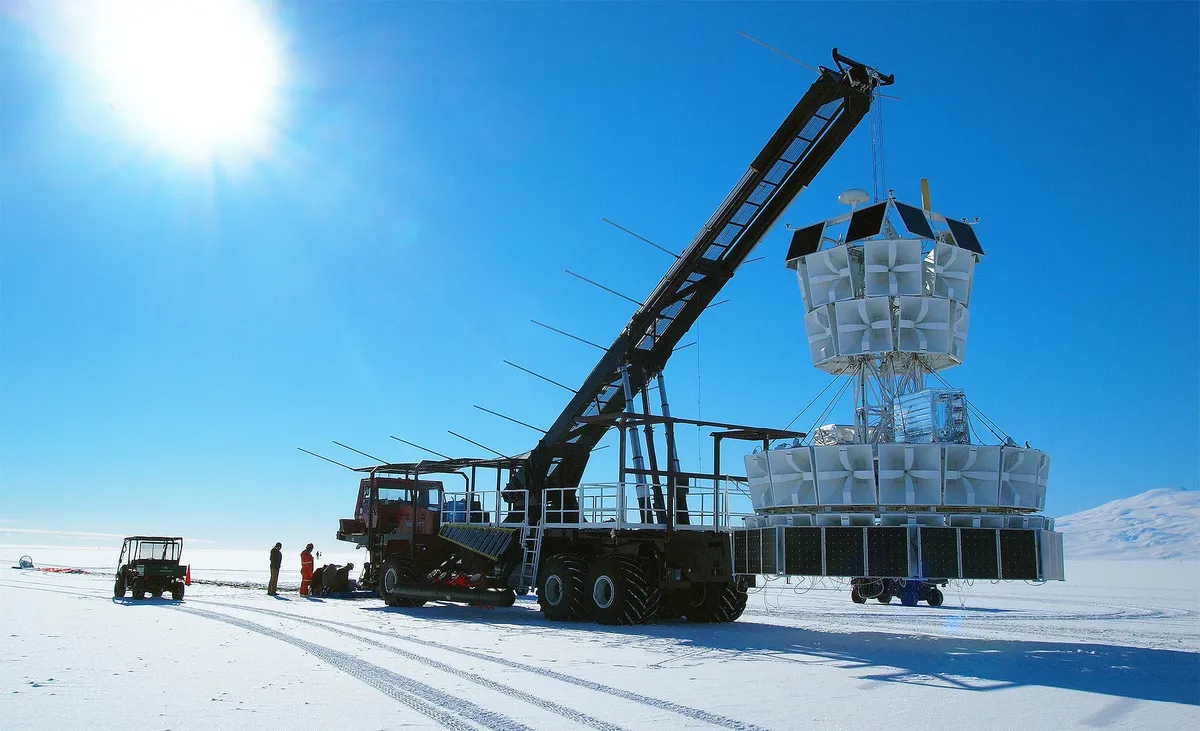
Antarctica, renowned for its stunningly clear skies, serves as an unparalleled vantage point for astronomical observations. The continent's unique environment allows for exceptional eavesdropping on the cosmos, making it an ideal location for scientific exploration. At the forefront of this research is a NASA balloon carrying the Antarctic Impulsive Transient Antenna, or ANITA. This groundbreaking experiment captures the faint radio signals generated when ultra-energetic cosmic rays collide with the Earth's atmosphere.
Most of the radio signals detected by ANITA behave as physicists predict: they flip polarity after reflecting off the two-mile-thick ice sheet, creating a clean mirror image. This reflection informs researchers that the originating particle came from above the ice. However, ANITA has also recorded a series of unusual pulses that do not conform to these expected behaviors. The presence of these signals is particularly troubling, as they suggest that a particle has traversed the Earth, traveling over 3,000 miles of rock before emerging from the ice on the opposite side. Such a feat is not expected from any known particle.
The peculiar pulses detected by ANITA arrive at unexpectedly steep angles, emerging from approximately 30° below the horizon. This deviation from the normal, gentler slopes associated with typical cosmic-ray echoes raises significant questions. Despite extensive verification efforts, the team confirmed that these pulses are genuine signals, not mere instrumental errors. Stephanie Wissel, an associate professor of physics, astronomy, and astrophysics, emphasizes the enigma, stating, “It’s an interesting problem because we still don’t actually have an explanation for what those anomalies are, but what we do know is that they’re most likely not representing neutrinos.”
Distinguishing authentic particle signatures from background noise is a meticulous process. Researchers analyze thousands of hours of data from the balloon using computer models that simulate the detector’s responses to various sources of interference such as lightning, satellite signals, and the crackling of auroras. By comparing these simulations to real events, they can filter out anything that doesn’t exhibit the characteristic shape of a particle-induced radio shower. Additionally, the ANITA collaboration collaborates with ground networks like IceCube and the Pierre Auger Observatory to validate their findings. Any signal that appears solely in the balloon logs undergoes rigorous examination.
Neutrinos are often considered the prime suspects in these enigmatic signals. As the universe's most elusive particles, neutrinos rarely interact with matter, making them invaluable for probing distant cosmic events. However, their elusive nature also complicates detection efforts. Wissel highlights the paradox, stating, “You have a billion neutrinos passing through your thumbnail at any moment, but neutrinos don’t really interact.” Detecting these particles could mean they have traveled vast distances without colliding with anything else, possibly originating from the edge of the observable universe.
To enhance the detection of neutrinos, ANITA operates approximately 25 miles above the Antarctic ice, significantly increasing each antenna's coverage area without needing physical structures on the ice. “We have these radio antennas on a balloon that flies 40 kilometers above the ice in Antarctica,” Wissel explains. “We point our antennas down at the ice and look for neutrinos that interact in the ice, producing radio emissions that we can then sense with our detectors.”
Upon tracing the unusual signals backward, the team discovered that their trajectories indicated movement through the Earth’s interior, contradicting established particle physics models. Further investigations using data from IceCube and Auger found no corresponding events, narrowing the range of conventional explanations. Wissel speculates, “My guess is that some interesting radio propagation effect occurs near ice and also near the horizon that I don’t fully understand, but we certainly explored several of those, and we haven’t been able to find any of those yet either.”
The next phase of this research is the Payload for Ultrahigh Energy Observations, or PUEO, scheduled for its inaugural Antarctic mission in December 2025. This new experiment will feature additional antennas and more advanced electronics, improving sensitivity by at least five times compared to ANITA. Wissel expresses her enthusiasm, stating, “In principle, we should pick up more anomalies, and maybe we’ll actually understand what they are. We also might detect neutrinos, which would in some ways be a lot more exciting.”
Across various platforms, instruments buried deep in ice or orbiting in space are making remarkable strides in cosmic research. Notably, a detector beneath the Pacific seafloor recently recorded the highest energy neutrino ever observed, highlighting the rapid advancements in this field. Whether ANITA’s anomalies will turn out to be exotic particles or an artifact of radio propagation, forthcoming missions promise to unveil new insights. Until then, the scientific community and enthusiasts alike await further revelations about the mysteries of the universe.
For more engaging articles, exclusive content, and the latest updates, consider subscribing to our newsletter. Don't forget to check out EarthSnap, a free app brought to you by Eric Ralls and Earth.com.